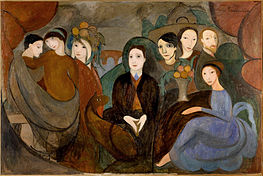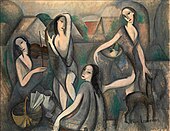Marie Laurencin
Marie Laurencin | |
|---|---|
 Marie Laurencin, c. 1912, Paris | |
| Born | 31 October 1883 Paris, France |
| Died | 8 June 1956(aged 72) Paris, France |
| Known for | Painter |
| Movement | Cubism |
You can helpexpand this article with text translated fromthe corresponding articlein French.(June 2020)Click [show] for important translation instructions.
|
Marie Laurencin(31 October 1883 – 8 June 1956) was a French painter and printmaker.[1]She became an important figure in the Parisianavant-gardeas a member of theCubistsassociated with theSection d'Or.
Biography
[edit]Laurencin was born in Paris,[2]where she was raised by her mother and lived there for much of her life. At 18, she studiedporcelain paintinginSèvres.She then returned to Paris and continued her art education at the Académie Humbert, where she changed her focus tooil painting.

During the early years of the 20th century, Laurencin was an important figure in the Parisianavant-garde.A member of both the circle ofPablo Picasso,and Cubists associated with theSection d'Or,such asJean Metzinger,Albert Gleizes,Robert Delaunay,Henri le Fauconnier,andFrancis Picabia,exhibiting with them at theSalon des Indépendants(1910–1911) and theSalon d'Automne(1911–1912), andGaleries Dalmau(1912) at the first Cubist exhibition in Spain. She became romantically involved with the poetGuillaume Apollinaire,and has often been identified as his muse. In addition, Laurencin had important connections to thesalonof the Americanexpatriateand lesbian writerNatalie Clifford Barney.She had relationships with men and women,[3]and her art reflected her life, her "balletic wraiths" and "sidesaddleAmazons"providing the art world with her brand of" queer femme with a Gallic twist. "[4]She had a forty years long love relationship with fashion designerNicole Groult.
During theFirst World War,Laurencin left France for exile in Spain with her German-born husband, the artist, Baron Otto von Waëtjen, since through her marriage she had automatically lost her French citizenship. The couple subsequently lived together briefly inDüsseldorf.She was greatly affected by her separation from the French capital, the unrivaled center of artistic creativity.[5]After they divorced in 1920, she returned to Paris, where she achieved financial success as an artist until the economic depression of the 1930s. During the 1930s she worked as an art instructor at a private school. She lived in Paris until her death.
Work
[edit]Laurencin's works include paintings, watercolors, drawings, and prints. She is known as one of the few femaleCubistpainters, withSonia Delaunay,Marie Vorobieff,andFranciska Clausen.[citation needed]While her work shows the influence of Cubist paintersPablo PicassoandGeorges Braque,who was her close friend, she developed a unique approach toabstractionwhich often centered on the representation of groups of women and animals. Her work lies outside the bounds of Cubist norms in her pursuit of a specifically feminine aesthetic by her use of pastel colors and curvilinear forms. Originally influenced byFauvism,she simplified her forms through the influence of the Cubist painters. From 1910, her palette consisted mainly of grey, pink, and pastel tones.[6]
Her distinctive style developed upon her return to Paris in the 1920s post exile. The muted colours and the geometric patterns inherited from Cubism were replaced by light tones and undulating compositions.[7]Her signature motif is marked by willowy, ethereal female figures, and a palette of soft pastel colours, evoking an enchanted world.[8]Art history professor Libby Otto said, "Marie Laurencin is of the 'lipstick lesbian' variety: She constructs this very soft, feminine world that really spoke to viewers at the time. And if you realize that, in her soft way, she's constructing a world without men, of female harmony, there's something pretty revolutionary in there as well."[9]
Laurencin continued to explore themes of femininity and what she considered to be feminine modes of representation until her death. Her works include paintings, watercolors, drawings, and prints.
- Selected works
-
1910-11,Les jeunes filles (Jeune Femmes, Young Girls),oil on canvas, 115 x 146 cm. ExhibitedSalon des Indépendants,1911,Moderna Museet,Stockholm
-
1911,La Toilette des jeunes filles (Die Jungen Damen),black and white photograph. Exhibited at the 1913Armory Show,New York, Chicago and Boston
-
1912,Femme à l'éventail (Woman with a Fan),black and white photograph published inAlbert Gleizes,Jean Metzinger,Du "Cubisme",Edition Figuière, Paris, 1912
-
1913,Le Bal élégant, La Danse à la campagne
-
1921,Portrait de Jean Cocteau,[referring toJean Cocteau.]
-
1921,Woman Painter and Her Model,oil on canvas
-
1923,Portrait de Mademoiselle Chanel[referring toCoco Chanel], oil on canvas
-
1923,Femmes au chien,oil on canvas
-
1924,Self-Portrait,oil on canvas
Collections
[edit]Laurencin's artistic accomplishments are seen in collections around the world. On the 100th anniversary of her birth in 1983, the Musée Marie Laurencin opened in Nagano, Japan.[10]To date, the Musée Marie Laurencin is the only museum in the world that solely contains the art of a female painter. FounderMasahiro Takanowas enamored with Laurencin's sensual and lyrical worldview, and the museum holds over 600 art pieces by her.
Laurencin's work is also found inThe Museum of Modern Artin New York, theBarnes Foundationin Philadelphia, theHermitage Museumin St. Petersburg, and theTate Galleryin London. Her work is also shown in the permanent collection of theMusée de l'Orangeriegallery in Paris, France, housing some of her most famous pieces.
In 2023, theBarnes Foundationopened a retrospective of Laurencin's work, titledMarie Laurencin: Sapphic Paris.[11]
See also
[edit]- The Spanish Dancers,a 1921 painting by Laurencin
Notes
[edit]- ^Maurice Raynal:Modern French Painters,Ayer Publishing, 1928, p. 108.ISBN978-0-405-00735-4.
- ^Phaidon Editors,Great Women Artists.Phaidon Press, 2019, p. 233.ISBN978-0714878775
- ^"Laurençin, Marie".glbtq.Archived fromthe originalon 21 September 2013.
- ^Pilcher, Alex (2017).A Queer Little History of Art.London: Tate Publishing. p. 37.ISBN978-1-84976-503-9.
- ^"Musée d'Orsay".
- ^"Marie Laurencin | Musée de l'Orangerie".musee-orangerie.fr.Retrieved27 September2020.
- ^"Musée d'Orsay".
- ^"Marie Laurencin | Musée de l'Orangerie".musee-orangerie.fr.Retrieved27 September2020.
- ^Lange, Maggie,"The Exhibition Making the Case for Art Without Men"The New York Times,25 October 2023.
- ^"Sotheby's - Marie Laurencin".
- ^Chernick, Karen (16 January 2024)."A Marie Laurencin Exhibition Offers a View into the Lesbian Circles of 1920s Paris".ARTnews.Retrieved17 January2024.
References
[edit]- Birnbaum, Paula J.Women Artists in Interwar France: Framing Femininities,Aldershot, Ashgate, 2011.
- Fraquelli, Simonetta, and Kang, Cindy, eds.Marie Laurencin: Sapphic Paris,Barnes Foundation,2023. Catalog to exhibition listed under External links.
- Gere, Charlotte.Marie Laurencin,London - Paris, Flammarion, 1977
- Groult, Flora.Marie Laurencin,Paris, Mercure de France, 1987
- Kahn, Elizabeth Louise. "Marie Laurencin: Une Femme Inadaptée" inFeminist Histories of ArtAshgate Publishing, 2003.
- Marchesseau, Daniel.Marie Laurencin,Tokyo, éd. Kyuryudo & Paris, Hazan, 1981
- Marchesseau, Daniel.Marie Laurencin, Catalogue raisonné de l'œuvre gravé,Tokyo, éd. Kyuryudo, 1981
- Marchesseau, Daniel.Marie Laurencin, Catalogue raisonné de l'œuvre peint,2 vol. Tokyo, éd. Musée Marie Laurencin, 1985 & 1999
- Marchesseau, Daniel.Marie Laurencin, Cent Œuvres du musée Marie Laurencin,Martigny, Fondation Pierre Gianadda, 1993
- Marchesseau, Daniel,Marie Laurencin,Paris, Musée Marmottan Monet / Hazan, 2013
- Otto, Elizabeth(2002)."Memories of Bilitis: Marie Laurencin beyond the Cublist Context".genders.org.Archived fromthe originalon 12 February 2007.
- Pierre, José.Marie Laurencin,Paris, France-Loisirs, 1988
- "Marie Laurencin".Artnet.Artnet. Retrieved 10 March 2021.
- "History".marielaurencin.jp.Musée Marie Laurencin. Retrieved 9 March 2021.
- "Musée d'Orsay".musee-orangerie.fr.National Museums Meeting - Grand Palais. Retrieved 10 March 2021.
- Archives
- Fonds Marie Laurencin, Bibliothèque littéraire Jacques Doucet, Université de Paris
External links
[edit] Media related toMarie Laurencinat Wikimedia Commons
Media related toMarie Laurencinat Wikimedia Commons
- Marie Laurencin Bio- Findlay Galleries
- Marielaurencin
- Musée Marie Laurencin,Japan.
- Artcyclopedia: Marie Laurencin
- Marie Laurencin: Sapphic ParisExhibition at theBarnes Foundation,22 October 2023 - 21 January 2024.The New York TimesreviewArt HerstoryreviewBroad Street Review
- 1883 births
- 1956 deaths
- French women painters
- 20th-century engravers
- Artists from Paris
- French engravers
- French women printmakers
- French bisexual women
- French bisexual artists
- Bisexual women artists
- Bisexual painters
- French LGBTQ painters
- French modern painters
- Modern printmakers
- French cubist artists
- Burials at Père Lachaise Cemetery
- 20th-century French women artists
- 20th-century French printmakers
- Muses
- Women engravers
- People of Montmartre





![1921, Portrait de Jean Cocteau ,[referring to Jean Cocteau.]](https://upload.wikimedia.org/wikipedia/en/thumb/2/28/Marie_Laurencin%2C_1921%2C_Portrait_de_Jean_Cocteau.jpg/140px-Marie_Laurencin%2C_1921%2C_Portrait_de_Jean_Cocteau.jpg)

![1923, Portrait de Mademoiselle Chanel [referring to Coco Chanel], oil on canvas](https://upload.wikimedia.org/wikipedia/en/thumb/6/6e/Portrait_de_Mademoiselle_Chanel_1923_Oil_on_canvas.jpg/136px-Portrait_de_Mademoiselle_Chanel_1923_Oil_on_canvas.jpg)

